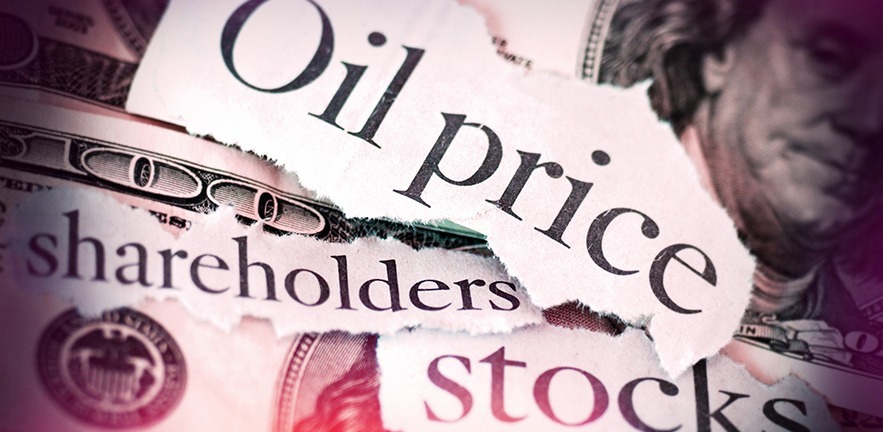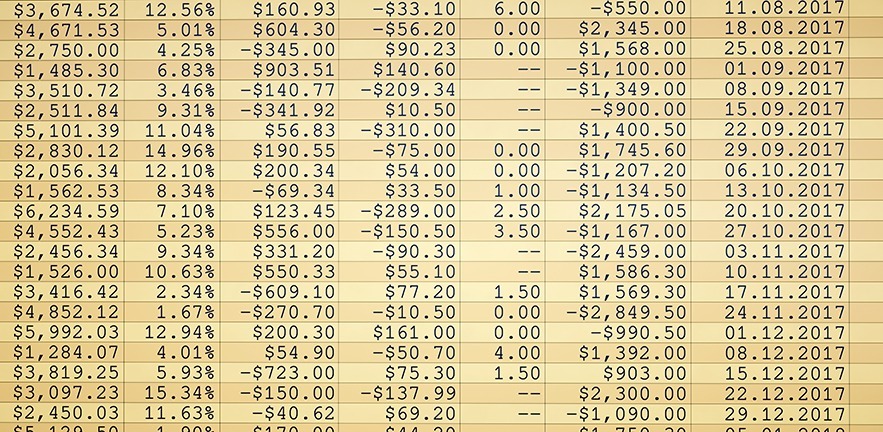
Finance and accounting
Natural, social and financial capitals
Explore the impact of financial development on biodiversity loss in Italy and learn how social capital influences financial growth.

Finance and accounting
What is the impact of mergers and acquisitions (M&A) on talent reallocation?
By analysing a sample of 803 public M&A deals spanning over 3 decades, CERF research associate Luxi (Lucy) Wang studies the impact of M&As on innovative labours by examining inventors’ turnovers and productivity changes.

Finance and accounting
Enhancing real estate investment trust return forecasts via machine learning
Thies Lindenthal and Kahshin Leow cover the enhancing of real estate investment trust return forecasts by the use of machine learning.

Career and personal development
The quality of the relationship between employees and management
Sunwoo Hwang, an Assistant Professor of Finance at Korea University Business School, and Biwon Lee, a finance PhD candidate at W.P. Carey School of Business at Arizona State University, measure the quality of the relationship between employees and management and examine its causal effects on business outcomes such as profitability, labour productivity, and employee retention.

Governance, economics and policy
Was there a bubble for Remain on the night of the EU referendum?
Cambridge Endowment for Research in Finance (CERF) Research Associate, Tom Auld, explores whether markets were irrationally overconfident as results unfolded on the night of the UK’s Brexit referendum.

Research centre news
The effects of seasonality on corporate real decisions
CERF post-doctoral researcher Kevin Schneider studies the effect of seasonal output prices on a firm’s inventory and stock returns. He finds that seasonal inventory holdings help explain several stock return anomalies.

Research centre news
Why are star firms important in the market?
This blog post discusses the significant role of 'star firms' in the financial markets, a concept introduced by Gutiérrez and Philippon (2019). These firms are not only large in their sectors but also profoundly impact market dynamics in the US.

Research centre news
Trust matters: how social trust shapes international investments
Marwin Mönkemeyer, Research Associate at Cambridge Centre for Finance (CCFin) and Cambridge Endowment for Research in Finance (CERF), blogs about the role of social trust in the portfolio allocation decisions of global institutional investors.

Research centre news
Understanding the impact of sovereign accounting errors on financial markets
Cambridge Judge Associate Professor and Cambridge Endowment for Research in Finance (CERF) Research Fellow Dr Jenny Chu looks at the market consequences of sovereign financial reporting errors.

Career and personal development
The impact of workplace relationships on manager incentivisation and fund performance
What are the effects of favouritism on employee incentives and behaviour more generally? Do well-connected mutual fund managers exert less effort in managing their funds? Why do mutual fund companies tolerate favouritism? These are some of the questions explored by Elias Ohneberg, who is a research associate at the Cambridge Endowment for Research in Finance.

ESG and sustainability
Do short sellers care about Environment, Social and Governance?
CERF Fellow Oğuzhan Karakaş, and research collaborators Pedro Saffi (a former CERF fellow) and Mehrshad Motahari (a former CERF Research Associate), analyse whether the short sellers can anticipate negative ESG incidences of firms, and make money from the negative price reactions to the news announcement of such incidences.

ESG and sustainability
Green transmission: monetary policy in the age of Environment, Social and Governance
How sensitive are green firms to monetary policy? Alba Patozi, PhD student at the University of Cambridge (Faculty of Economics) explores this question in a recent paper that won the 2023 CERF/Cambridge Finance Best Student Paper Award.

Finance and accounting
Why do investment companies abandon sustainability?
Yuxia Zou, Cambridge Judge PhD student and Research Associate at the Cambridge Endowment for Research in Finance (CERF), looks at when and why an investment company would abandon its public commitment to sustainability.

Cambridge Judge PhD candidate and Cambridge Endowment for Research in Finance (CERF) Research Associate, Elias Ohneberg looks at the effect of employee satisfaction on performance of those working in mutual funds.

Xinyu Hou, Research Associate at Cambridge Centre for Finance (CCFin) and Cambridge Endowment for Research in Finance (CERF), blogs about how shareholder liability is limited when it comes to damage to others caused by their corporations.

Research centre news
The pricing of foreign exchange and the unique role of US Dollar risk
Trading in over-the-counter foreign exchange (FX) markets reached $7.5 trillion per day in April 2022 across all FX instruments (BIS, 2022), making it the most actively traded asset class, globally.

During the past few decades, corporate social responsibility (CSR) issues have attracted enormous attention from regulators and the investment community around the world. Until now, the most widely adopted measure is CSR-related reporting, which is believed to be a critical ingredient in achieving broader CSR goals.

Research centre news
Portfolio selection, periodic evaluations and risk taking
Portfolio managers in real life can be selfish, where they care about their own short-term periodic incentives rather than the long-term portfolio growth. How will their risk-taking behaviours change in such a case?

Whichever way you look at it, the London Stock Exchange is in secular decline. The number of companies listed on the exchange's Main Market has fallen from over 4,400 in the early 1960s to less than 1,200 now.

In the early days of Federal Express, the company once was down to $5,000 in its checking account, not able to cover the $24,000 jet fuel bill due the following Monday.

During recessions, central banks play a key role to support the economy. They are often concerned with avoiding bad outcomes for macroeconomic growth or mitigating "downside risks".

by Dr Shiqi Chen, Research Associate, Cambridge Centre for Finance and Cambridge Endowment for Research in Finance One standard assumption of the existing corporate finance literature is firms' policies are set to maximise total shareholders' value, irrespective of individual stockholders' personal preferences. Shareholders who disagree with the firm's policies can sell off their holdings and invest in alternative investment opportunities. However, this assumption is only valid for public traded firms with well-diversified investors, which is not the norm when we look at the existing business entities in the economy. Indeed, many business entities are not traded on the public market and are governed by a small group of investors with heterogenous preferences, beliefs, investment horizons etc. For example, many small family firms are often owned and run by a few family members whose preferences are different, and whose livelihoods are tied to the firm's income. Another example is mutual fund management teams, which consist of several managers with different preferences, career stages, risk tolerance etc. These differences are reflected in their choices of assets and therefore determine their compensation. Similarly, VC syndicates often involve partners with different investment preferences and horizons. Under such circumstances, what entities involving heterogeneous stockholders should…

Starting with Marquis de Condorcet (1785), a large literature seeks to understand voting in settings where agents possess private information about the desirability of choices.

Overall, our results emphasise the role of the institutional shareholdings network as a corporate governance mechanism that influences accounting quality and shed light on how investors obtain valuable information for monitoring.

by Professor Adam Meirowitz, David Eccles School of Business, University of Utah, Dr Shaoting Pi, Research Associate, Cambridge Centre for Finance and Cambridge Endowment for Research in Finance, University of Cambridge, and Dr Matthew C. Ringgenberg, David Eccles School of Business, University of Utah Voting plays an important role in corporate governance. Shareholders vote to elect members of the board of directors, and they vote on proposals that may directly affect the actions of the firm. Similarly, members of the board of directors vote to appoint the chief executive officer and vote on a variety of firm policies. Traditionally, these stakeholders broadly agreed on the objective of the firm – maximise firm value – and this one-dimensional objective simplified voting.[1] Yet more recently, a number of academics, practitioners, and regulators have argued that firms ought to care about more than just value. While concern over environmental, social, and corporate governance (ESG) is exploding, there has been little conceptual work evaluating whether this shift in the scope of what matters to shareholders and board members impacts the performance of firm governance.[2] How does one conceive of firm governance in the presence of ESG concerns? One defensible position is that now board…

In the post WW2 period, the cross-country correlations between the stock markets in developed economies were fairly low, implying significant potential benefits from diversification.

Mitigating climate change has become one of the defining challenges of our time. Indeed, there is global concern about the potentially disastrous long-term consequences of unmitigated climate change.

Unlike what is often assumed in the standard corporate finance literature that firms are often governed by a single representative agent on behalf of the principal, in reality, many corporate decisions are indeed determined by a group of agents or investors, who are heterogeneous in many dimensions.

When studying the allocation of household assets, virtually all existing papers start with the household as the primitive unit of analysis (Gomes et al. 2020).

In the study of enterprise ownership comparisons between ownership by investors of capital, suppliers of labour, or customers is widespread. Little attention, however, has been allocated to the connections between governance by owners and the ease with which ownership status can be changed.

This year's UN Climate Change Conference, COP26, has been in the centre of a controversial debate over the extent to which current climate change mitigation measures are (in)sufficient to limit the rise in average global temperatures to 2°C – let alone 1.5°C – above pre-industrial levels.

Activist shareholders, who exert a large influence on firms' policies, typically only own small stakes and frequently interact with fellow shareholders of target firms.

The 2008-2010 financial crisis and the COVID-19 (coronavirus) pandemic have highlighted the importance of an orderly insolvency resolution mechanism (hereafter IRM).

At the beginning of the COVID-19 (coronavirus) crisis, a massive drop in global dividends occurred as firms struggled to preserve cash in this unprecedented world health crisis. While Royal Dutch Shell and British Petroleum cut their dividend for the first time since the Second World War and the 2010 Deepwater Horizon Disaster, respectively, Exxon continued its thirty-seventh increase in the dividend.

Green, or environmentally friendly, companies have generated significantly higher stock returns compared to their brown peers in recent years.

Insight
Corporate Darwinism
Only 19 of 1,513 UK companies survived 70 years after mandatory consolidated accounts in 1948, says natural selection-inspired study at Cambridge Judge Business School.

We are entering into an era of Big Data, in which the demand and supply of data and information are growing exponentially. Such unprecedented demand and supply have triggered reforms in many sectors, where the financial industry is at the forefront of the trend.

One of the most frequently asked questions in the financial news media this year has been whether the stock market is in a 'bubble'?

The risk of climate change and its potentially drastic consequences has reshaped many industries in recent years. The financial industry has been no exception to this trend.

Debt-equity conflict is undoubtfully one of the core paradigms of corporate finance research.

by Dr Mehrshad Motahari, Research Associate, Cambridge Centre for Finance and Cambridge Endowment for Research in Finance A large body of literature documents how firms' geographical locations can affect their stock returns. For example, Pirinsky and Wang (2006) show that the stock returns of firms headquartered in the same geographical area comove with each other. They argue that this comovement is not related to economic fundamentals but to the trading patterns of local investors. Various papers attribute this excess comovement to local bias that induces local investors to take larger positions in local stocks. Bernile et al. (2015) suggest that even institutional investors overweigh firms whose 10-Ks frequently mention the investors' state. In contrast, Kumar et al. (2013) show that retail trades cause comovement in local stocks, whereas institutional trades mitigate the issue. Local bias also leads to the incorporation of the behaviours and preferences of local investors in the prices of local stocks. Korniotis and Kumar (2013) highlight that local risk tolerance affects the returns of local stocks. Specifically, they argue that US state-level heterogeneity in economic conditions leads to variations in investor risk tolerance across states, and heterogeneous risk tolerance results in variations in the cross section of…

2020 has been the year of special purpose acquisition companies or SPACs. A SPAC is a blank check shell company designed to take private companies public without going through the traditional initial public offering (IPO) process.

by Dr Hormoz Ramian, Research Associate, Cambridge Centre for Finance and Cambridge Endowment for Research in Finance Regulatory interventions have always been ensued by heated debates. In the years after the financial crisis reached its darkest moment, academic literature and high legislative chambers were inundated by discussions related to risk-based capital requirements. Opponents often have expressed dissatisfaction against the intervention arguing that capital holding above the laissez-faire outcome is expensive to the banking institutions leading to lower lending and ultimately suppressed economic growth. Proponents of the regulation have argued that fragility of the banking sector, that is associated with a significant economic cost to the society, rationalises the intervention. Despite prolonged arguments presented by the opposing sides, these debates rarely reached an agreeable conclusion. An important but often ignored reason to the disagreement was that the arguments emanated from incomparable bases. More specifically, the opponents' view presented by the banking institutions weighed heavily on the cost of equity as the central reason to rail against capital holdings above the laissez-faire outcome (Basel Committee on Banking Supervision Reports 2014, 2016, Acharya et al, 2017). Ignoring the underlying merits behind their argument for the moment, their perspective focused on the role of…

Machine learning (ML) is the most important branch of artificial intelligence (AI), providing tools with wide-ranging applications in finance. My previous blog posts ('Can robots beat the market?' and 'Artificial intelligence in asset management: hype or breakthrough?') discuss some of the most important ML applications in finance.

Little is known about the implications of contingent employment on firm outcomes says CFin Research Associate Sunwoo.

by Hormoz Ramian, Research Assistant, Cambridge Centre for Finance and Cambridge Endowment for Research in Finance The negative interest rate has been among the frontier policies to counter the recent economic downturns. The 2020 pandemic resurfaced the policy's role that was originally deployed to assuage prolonged slowdowns associated with the aftermath of the 2008 financial crisis. While lowering the cost of financing is a well-established policy initiative in response to adverse economic outcomes, the effective pass-through implications of the negative interest rates through the financial intermediaries remains an open question. Policymakers examine how negative interest rates lead to real economic implications through the financial intermediaries. The interest rate policy (alternatively known as the bank rate or the federal funds rate) is primarily a monetary policy. Nevertheless, its tight relationship with the interest-on-excess-reserves (IOER), paid on oversized excess reserves held by the banking institutions, generates substantial impacts on the overall performance of the banks and their lending. This provides motivation to first, investigate how the negative interest rate policy is translated to an ultimate lending rate for the real economy through the banking institutions. Second, the tight relationship between the main monetary policy and the IOER provides motivation to examine how…

by Dr Adelphe Ekponon and Dr Scott Guernsey, Research Associates, Cambridge Centre for Finance and Cambridge Endowment for Research in Finance Motivated by preliminary empirical evidence showing that firms with more committed managers tend to suffer less during downturns, CERF Associates Adelphe Ekponon (now at the University of Liverpool) and Scott Guernsey (now at the University of Tennessee) propose a model to help understand the mechanisms under this phenomenon. Economic crises bring about periods of prolonged turmoil. During such periods, shareholders have difficult decisions to make, in particular, regarding the retention or firing of the incumbent management team (assuming also that the change of CEO is likely to be followed by a reshuffle of the managing team). There exists a labour market for executives with two possible statuses. An executive team can be either the incumbent or an entrant. This framework assumes that the labour market for executives is not only competitive but is also highly restrictive, as managers do not have many outside options. Thus, there exists a lack of diversification in the labour market – i.e. they are "all-in" on the firm. This incites executives to be committed to the firm and exert more effort. In practice, the…

by Dr Mehrshad Motahari, Research Associate, Cambridge Centre for Finance and Cambridge Endowment for Research in Finance The growing trend of replacing active investment managers with computer algorithms (The Economist, 2019) has led to a surge in the use of artificial intelligence (AI)[1] in investing. This means that more AI-based algorithms (alpha algos) are being used to devise investment strategies. In most cases, the algorithm itself tests the viability of these strategies and even executes trades while keeping transaction costs to a minimum. A common question, however, is whether these algorithms can generate profitable investments. The following is a summary of findings from a number of recent studies on the issue. AI-based investment strategies often use forecasts of future asset performance metrics, the most popular being returns. AI models utilise a range of data inputs, including technical and fundamental indicators, economic measures, and texts (like online posts and news articles), to predict future returns (Bartram, Branke, and Motahari, 2020). These predictions then form the basis of an investment strategy by rebalancing portfolio weights to favour stocks that will outperform and to move away from those that will underperform. In a recent hallmark study, Gu, Kelly, and Xiu (2020) investigate a…

Early-stage finance research exploring the impact of COVID-19 on important financial outcomes such as household spending and investor expectations, by Dr Scott Guernsey, Research Associate at the Cambridge Centre for Finance and the Cambridge Endowment for Research and Finance (CERF). In the first article, "How does household spending respond to an epidemic? Consumption during the 2020 COVID-19 pandemic", Professors Scott Baker (Northwestern University), Robert Farrokhnia (Columbia University), Steffen Meyer (University of Southern Denmark), Michaela Pagel (Columbia University), and Constantine Yannelis (University of Chicago) investigate how US households altered their consumption behaviour in response to the COVID-19 (coronavirus) outbreak. Using transaction-level household financial data, the paper finds that households' spending markedly increased as initial news about the spread of COVID-19 in their local area intensified. The initial increase in spending suggests that households were attempting to stockpile essential goods in anticipation of current and future disruptions in their ability to frequent local retailers. Meanwhile, as COVID-19 spread, more households remained at home, sharply decreasing their spending at restaurants and retail stores, and their purchase of air travel and public transportation. These effects are magnified for households in states that issued "shelter-in-place" orders, with the increases in grocery spending nearly three times…

Most papers, that study determinants of cryptocurrency prices, find no relation to existing market factors. In a work-in-progress, CCFin/CERF Research Associate Adelphe Ekponon and Kassi Assamoi (Liquidity Analyst at MUFG Securities and University of Warwick) examine a portfolio approach to explore cross-sectional pricing within crypto-market. At its inception, Bitcoin meant to be an alternative to fiat currencies. Yet high returns in this market may have also attracted usual investors as well, as they are looking for more investments and diversification venue. Since Bitcoin, the number of cryptocurrencies has reached more than 6,000 as of the beginning of 2020, according to coingecko.com. Hence, investors have more choices when they decide to enter into the crypto-market. So, they have an incentive to understand the crypto-market interaction with their current investment. Their paper belongs to two trends. The first one explores portfolio strategies and cross-sectional pricing to study factors embedded into major asset classes, stocks or/and bonds as in Fama-French (1989, 1992), Cochrane and Piazzesi (2008), and Koijen, Lustig, and Van Nieuwerburgh (2017); currencies as in Lustig and Verdelhan (2005); and commodity as in Fama-French (1987), and Bakshi, Gao, and Rossi (2015). The second line examines the determinants of cryptocurrency prices and returns.…

by Dr Mehrshad Motahari, Research Associate, Cambridge Centre for Finance and Cambridge Endowment for Research in Finance Artificial intelligence (AI) has become a major trend and has disrupted most industries in recent years. The financial services sector has not been an exception to this development. With the advent of fintech, which has had an emphasis on the use of AI, the sector has experienced a revolution in some of its core practices. Asset management is probably the most affected practice and is expected to suffer the highest number of job cuts in the foreseeable future. A sizeable proportion of asset management companies are now using AI instead of humans to develop statistical models and run trading and investment platforms. In a recent article entitled "Artificial intelligence in asset management", CERF Research Associate Mehrshad Motahari and co-authors Söhnke M. Bartram and Jürgen Branke (Warwick Business School, University of Warwick) provide a systematic overview of the wide range of existing and emerging AI applications in asset management and set out some of the key debates. The study focusses on three major areas of asset management in which AI can play a role: portfolio management, trading, and portfolio risk management. Portfolio management involves…

A large literature in international finance has established the relevance of a wide array of frictions in financial investments across borders leading to the concentration of equity investments within national borders (home bias in equity portfolios) and to large biases in the composition of investors' foreign equity portfolios (foreign bias). Moreover, despite increasing integration of international equity markets in recent decades, asymmetries in bilateral return comovement between equity markets remain large. In a working paper entitled "Asset pricing of international equity under cross-border investment frictions" and recently presented at the 2020 American Finance Association meetings in San Diego, CCFin/CERF research associate Argyris Tsiaras and collaborator Thummim Cho (LSE) undertake a systematic theoretical investigation of how the cross-sections of equity returns and portfolio holdings across countries are jointly shaped by investment frictions and other characteristics of individual countries or equity markets, such as market size or the comovement of cash-flow fundamentals. Overall, the authors argue that cross-country variation in the degree of cross-border investment frictions is the most important determinant of the cross-sections of equity return moments and of cross-border equity portfolio allocations. The paper investigates the implications of this observation for the literature on international asset pricing models, most of…

by Dr Scott B. Guernsey, Research Associate, Cambridge Centre for Finance and Cambridge Endowment for Research in Finance Ever since Milton Friedman's celebrated 1970 article – "The Social Responsibility of Business is to Increase its Profits" – the shareholder model of the corporation has commanded widespread acceptance amongst finance academics and practitioners. Under this model, share value maximisation provides the exclusive yardstick for managerial performance (Friedman, 1970), while discretion to consider the interests of other stakeholders (e.g. employees, suppliers, customers, creditors, and local communities) is interpreted as enabling managers to rationalise any self-serving action (i.e. "managerial moral hazard") (Tirole, 2001). More recently, however, both finance scholars and business leaders have started paying renewed attention to the interests of stakeholders (i.e. "stakeholder orientation"). For example, the article "A Theory of the Stakeholder Corporation", published in the Econometrica by Michael Magill (University of Southern California), Martine Quinzii (University of California, Davis), and Jean-Charles Rochet (University of Geneva), shows theoretically that firms that exclusively focus on shareholder maximisation are more exposed to certain risks that arise from their own investment and production decisions (i.e. "endogenous risks"). And further, that these risks generate negative externalities on stakeholders (e.g. lower wages for employees or higher…

by Dr Adelphe Ekponon, Research Associate, Cambridge Centre for Finance and Cambridge Endowment for Research in Finance In addition to internal funds, firms have two main sources of financing: equity and debt (in general, a mix of both). The latter source of financing comes with tax benefits, and its costs have been historically lower. However, relying heavily on debt financing could increase a firm's bankruptcy risk. This suggests that there should exist an optimal leverage level (level of debt over the total value of the firm) as suggested by the trade-off theory, i.e. Leland (1994). There is still some debate as to whether firms should use more debt than they do. According to Miller (1977), taxes are large and certain, whereas bankruptcy is rare and its dead-weight costs are low. Thus, firms should have higher leverage levels than what we observe. Myers (1977) argue that, in the presence of risky debt, equity holders underinvest (debt overhang) because an important fraction of the value generated by these new investments will accrue to debt holders. Debt overhang has also been shown to curb firms' innovation and investment (see Chava and Roberts, 2008). What about the effects of debt financing at the industry/aggregate level?…

Applications are invited for doctoral funding for up to three years starting in October 2020 from the Cambridge Endowment for Research in Finance (CERF). The scheme is open to PhD students within the University of Cambridge who do research into all aspects of finance, financial institutions, and financial markets, and their relationship with the performance of the economy.…

by Dr Mehrshad Motahari, Research Associate, Cambridge Centre for Finance and Cambridge Endowment for Research in Finance The Nobel Prize–winning Cumulative Prospect Theory of Tversky and Kahneman (1992) has revolutionised our understanding of how humans make economic decisions in the face of uncertainty. This theory takes all possible future outcomes and their probabilities into account and returns a value that shows how attractive a particular economic choice is for an individual. This is very similar to the function of expected utility but the two are fundamentally different. One particular area in which Cumulative Prospect Theory differs from the expected utility frameworks is the assignment of probabilities to uncertain outcomes. Unlike the expected utility framework which uses objective probabilities, Cumulative Prospect Theory transforms probabilities by assigning a weight to them. The outcome of this transformation is overweighting of low probabilities and underweighting of high probabilities. Probability weighting under Cumulative Prospect Theory may seem bizarre at first, but it can explain a number of longstanding puzzles in finance and economics. One particularly interesting one is gambling. Almost everyone knows in advance that the likely outcome of gambling is loss, so why do people gamble then? Cumulative Prospect Theory says that, even if…

Financial technology ("fintech") is a rapidly growing industry that applies recent digital innovations and technology-enabled business model innovations to financial services. A common example is its application of smartphone technologies to banking. For instance, from the convenience of a mobile phone, fintech consumers can access depository accounts, transfer funds, request loans, and pay monthly bills. Correspondingly, the emergence of the fintech industry has expanded the accessibility of many financial services to the general public. Recent regulation in the EU (the Second Payment Services Directive – PSD2) and the UK (the Open Banking initiative) suggests that policy makers generally regard fintech's entrance into the financial services industry favourably.[1] Mandated by these respective legislative actions, traditional banks must release data on their customers' accounts to authorised fintech firms, with the aim of opening "up payment markets", "leading to more competition, greater choice and better prices for consumers" (Summary of Directive (EU) 2015/2366 on EU-wide payment services). But is the competition/disruption created by fintech firms in financial services' markets always in the interests of consumers? And what role does the portability of data – as required by the PSD2 and the Open Banking initiative – play in these markets? A recent research article…

The agency problem, in the context of separation in ownership (shareholders or the principals) and control (managers or the agents), is one of the most important issues in corporate finance. This separation may induce conflicts of interest inherent in the kind of relationship where an agent is expected to work in the best interests of a principal. In the case of a company, these conflicts of interest arise when executives, or more generally insiders which could include controlling shareholders, favour their interests at the expense of the company's goals. There are various manifestations of this behaviour. Managers may appropriate part of the profits, sell the firm's output or assets at under the fair value to their own business, divert profitable growth options, or recruit unqualified relatives at high positions. See Jensen and Meckling (1976), La Porta et al. (2000, 2002), and Lambrecht and Myers (2008). Impacts of self-interested management on corporate choices and asset prices have been extensively described by several theoretical and empirical works. They document that entrenched managers tend to underinvest and choose lower leverage. In response, shareholders may force them to increase leverage, because coupon payment reduces the firm's free cash flows which limits the amount available…

by Dr Hui (Frank) Xu, Research Associate, Cambridge Centre for Finance and Cambridge Endowment for Research in Finance Since the emergence of the cryptocurrencies, they have quickly become the focus of asset managers. Although many ongoing debates about cryptocurrencies still remain to be solved, e.g. whether their value can be justified, their relationship with the fiat money endorsed by the central banks, they do offer an alternative opportunity for the investors to diversify their portfolios. Yet before constructing a portfolio that subsumes cryptocurrencies, a question has yet to be answered: what is their risk and return profile and what are the determinants? Since stocks markets are well developed and thoroughly studied, it is only intuitive to look at whether the factors that successfully account for stocks markets can also apply to the cryptocurrencies market. Although shares and cryptocurrencies are fundamentally different, they do share quite a number of similarities. Especially, some cryptocurrencies (digital tokens) represent the claim to the issuer. Eugene F. Fama and Kenneth R. French in 1992 found that size risk and value risk can account for the stock return in addition to the well-known beta, based on the evidence that value and small-cap stocks outperform market on…

The "poison pill" (formally known as a "shareholder rights plan") has a long and contentious history in the United States as a tactic to deter takeovers.[1] While details can vary across different implementations, the key defensive mechanism of the pill provides existing shareholders with stock purchase rights that entitle them to acquire newly issued shares at a substantial discount in the "trigger" event that a hostile bidder obtains more than a pre-specified percentage of the company's outstanding shares (e.g. 10 to 15 per cent).[2] As a result, poison pills permit a firm's board of directors the ability to substantially dilute the ownership stake of a hostile bidder, de facto giving the board veto power over any hostile acquisition. Correspondingly, law and finance scholars generally agree that the poison pill is perhaps the most powerful anti-takeover defence (e.g. Malatesta and Walkling 1988; Ryngaert 1988; Comment and Schwert 1995; Coates 2000; Cremers and Ferrell 2014). However, whether a firm's managers use the poison pill to the benefit or detriment of its shareholders is the subject of an enduring debate in both the corporate finance literature and in US state courts. Prior empirical studies have attempted to investigate the value implications of a…

As described in the article "The Choice between Formal and Informal Intellectual Property: A Review", published in the Journal of Economic Literature by Bronwyn Hall (University of California, Berkeley), Christian Helmers (Santa Clara University), Mark Rogers (Oxford University), and Vania Sena (University of Essex), the UK Community Innovation Survey suggests that most UK-based companies consider trade secrets one of the most effective mechanisms to protect their intellectual property. Further, the recent passing of the "Trade Secrets (Enforcement, etc) Regulations 2018" (SI 2018 No. 597) act by Parliament indicates that UK policymakers are also concerned with protecting domestic trade secrets. Loosely defined, trade secrets are configurations of closely held, confidential information (e.g. devices, formulas, methods, processes, programmes, techniques, etc.), which are used in a firm's operations, are not easily ascertainable by outside parties, and have commercial value for the holder because it is secret. Common examples include detailed information about a firm's customer contact and price lists, computer algorithms, cost information, and business plans for future products and services, among others.[1] Although, despite the simplicity and straightforwardness of these examples, the opaque and intangible nature of trade secrets makes it challenging for investors to appropriately assess the risk profiles and fundamental…

by Dr Adelphe Ekponon, Research Associate, Cambridge Centre for Finance and Cambridge Endowment for Research in Finance The very first asset pricing models (also called Capital Asset Pricing Models or CAPM) have postulated that the only risk that is needed to characterise a stock price is the contemporaneous correlation between the firm and the market portfolio returns. This implies that investors pay much more attention to information about the current economic conditions. Yet models that only incorporate this correlation risk tend to be unable to capture the dynamic of equity returns. The empirical asset pricing model proposed by Fama and French (1992) demonstrate that CAPM has no explanatory power to explain the cross-section of average stocks returns on portfolios sorted by size and book-to-market equity ratios. An important trend of the literature has developed models to improve pricing performances of the CAPM via a consumption-based approach, CCAPM. The main innovation of CCAPM models lies in the introduction of macroeconomic conditions into asset pricing. According to these models, risk premia should be proportional to consumption beta (correlation between the firm's profit and consumption). However, this line of CCAPM models are known to produce very little level of equity risk premium, less…

Financial markets faced a bumpy ride in 2018. The Financial Times report that global bond and equity markets shrank $5tn last year. Two major risks have been disrupting the markets during the past year: US-China trade dispute and Brexit. The two risks, however, are essentially the same: both would cause new frictions and impediments to the existing trade frameworks and unsettle investors' nerves. The risks may have consequences on firms' financing cost for real reasons. Take Brexit with no deal as an example. First, a firm's revenue can decline due to the friction in the product market, especially for British firms that heavily depend on the European markets. Second, the friction in the labour market may increase a firm's production cost. Both will lead to adverse effects on a firm's cash flow and, consequently, the firm's financing costs. However, the Brexit might also increase the firm's financing cost just because the investors become paranoid and exaggerate such adverse impacts brought by Brexit. Yet, to what extent does investor paranoia affect a firm's financing cost? The question is interesting for two reasons. First, although economists have been assuming investors to be rational, empirical evidence has challenged this view. Answering this question…

On the supply side, highly competitive industries are generally characterised as having many firms and low barriers to entry. The first condition implies that existing firms cannot dictate or influence prices, and the second that new firms can enter markets at any time and at relatively low cost when incentivised to do so. Taken together then, in equilibrium, this setting suggests that existing firms only earn enough revenue to remain competitive and cover their total costs of production. Yet, in reality, most industries in the United States have become increasingly less competitive. For example, in the article "Are US industries becoming more concentrated?", forthcoming in Review of Finance, Gustavo Grullon (Rice University), Yelena Larkin (York University), and Roni Michaely (University of Geneva), find that more than 75 per cent of US industries experienced an increase in concentration over the past two decades.[1] As such, these industries are now composed of fewer firms, are less at risk of entry by newcomers, and earn "economic rents" or revenues in excess of that which would be economically sufficient in a competitive environment. Given these new developments, it is important for shareholders to understand how a reduction in competition might affect their holdings. In…

by Dr Scott B. Guernsey, Research Associate, Cambridge Centre for Finance and Cambridge Endowment for Research in Finance Public distaste for high finance reached an all-time high in March of 2009, as the American International Group (AIG) insurance corporation announced it had paid out roughly $165 million dollars in bonuses to employees of its London-based financial services division (AIG Financial Products). Only months earlier, the same company had received roughly $170 million in US taxpayer-funded bailout money and suffered a quarterly loss of $61.7 billion – the largest corporate loss on record. Then Chairman of the US House Financial Services Committee, Barney Frank, remarked that payment of these bonuses was "rewarding incompetence". AIG countered, arguing that the bonuses had been pledged well before the start of the financial crisis and that it was legally committed to make good on the promised compensation. Additionally, Edward Liddy, who had been appointed chairman and CEO of AIG by the US government, said the company could not "attract and retain" highly skilled labour if they believed "their compensation was subject to continued… adjustment by the US Treasury." And AIG wasn't the only financial firm paying out large bonuses in 2009, as at least nine…

Probably every Fin 101 class teaches the principle of diversification: do not put all your eggs in one basket. Diversification allows investors to earn the same return but with possible lower risk. Theoretically, any rational investor would pursue the maximal amount of diversification of their portfolio, and as a consequence, every investor would end up with the same portfolio: market portfolio that only subjects to the systematic risk. In fact, this is one result of the Nobel Prize-winning Capital Asset Pricing Model (CAPM): any efficient portfolio can be replicated with a risk-free Treasury Bill and a market portfolio. But here comes the paradox: if everyone pursues the diversification to its extreme, the market, as a whole, ends up putting all eggs in the market portfolio. Thus, a disturbance to the market portfolio "as small as the flutter of a butterfly's wing can ultimately cause a typhoon" in the financial market. And this is corroborated by what occurred during the recent crisis of 2007-2009: many financial institutions holding diversified portfolios experienced serious creditor runs and suffered huge loss. A paper titled "Diversification and Systemic Bank Panics" by Professor Xuewen Liu at Hong Kong University of Science and Technology formalises such intuition…

We've heard all the buzz phrases, ranging from 'peer-to-peer lending' to 'cryptocurrencies'. But behind the hype, what exactly is alternative finance, and what are the benefits and risk? In this episode, joining podcast series host Michael Kitson, University Senior Lecturer in International Macroeconomics at Cambridge Judge Business School, are Robert Wardrop, co-founder of the Cambridge Centre for Alternative Finance; Stelios Kavadias, Margaret Thatcher Professor of Enterprise Studies in Innovation and Growth at Cambridge Judge, and Bart Lambrecht, Professor of Finance at Cambridge Judge. This is the seventh in a series of “Cambridge Judge Business Debate” podcasts featuring faculty and others associated with Cambridge Judge Business School and the broader Cambridge community. This latest podcast focuses on the topic of alternative finance, which includes cryptocurrencies such as bitcoin and also new routes for lending and borrowing that originate outside the traditional banking system. What is alternative finance? Michael Kitson: “Finance is the main lubricator of modern finance, but the financial sector itself is going through a period of rapid change – awash with a confusing range of new products and technologies such as cryptocurrencies, crowdfunding and peer-to-peer lending. So just what is ‘alternative finance'”? Robert Wardrop: “What it isn’t is private…

by Dr Alex S.L. Tse, Research Associate, Cambridge Centre for Finance and Cambridge Endowment for Research in Finance A few weeks ago I attended the 10th World Congress of the Bachelier Finance Society in Dublin. To those who do not know, this event is arguably the largest mathematical finance conference which only takes place once every two years. I gave a presentation on portfolio selection under transaction costs but today I am not going to talk about my own research (still, the interested ones can refer to this previous post!). In this blog entry I would like to give a brief overview on two topics which, in my opinion, have received considerable attention from both academics and practitioners during the conference. Rough volatility A cornerstone of modern asset pricing theory is the celebrated Black-Scholes option pricing formula. As elegant as the solution appears to be, it is well known that the underlying model is not consistent with real data. If we invert the formula to compute the volatility level of a stock implied by a set of option prices of different strikes and maturities, we will see that the implied volatilities obtained are not constant across the spectrum of options…

by Dr Yuan Li, Research Associate, Cambridge Centre for Finance and Cambridge Endowment for Research in Finance In 2013, the Nobel committee split the economic prize to Eugene Fama – the pioneer of efficient market hypothesis (EMH) and Robert Shiller – the critic of EMH. This decision indicated that the Nobel committee agreed with both Fama and Shiller. Was the committee right? The answer is yes, according to my findings from a recent research project. Fama explains EMH as "the simple statement that security prices fully reflect all available information". The empirical implication of this hypothesis is that except beta (the measurement of a firm's systematic risk), no other publicly available information can be used to predict stock returns. However, the finance literature has found that many easily available firm characteristics, such as market capitalisation, book-to-market ratio, etc, are related to future stock returns. They are the so-called anomalies. Does the discovery of anomalies reject the EMH? Not necessarily. Because no one knows what a firm's beta should be, and those firm characteristics can simply be proxies for beta. This is known as the joint hypothesis problem. We can say nothing about EMH unless we know what the correct asset…

Dr Jisok Kang, Research Associate, Cambridge Centre for Finance and Cambridge Endowment for Research in Finance Ever since the Capital Asset Pricing Model (CAPM) was first introduced in 1964, a well-accepted conception in the modern portfolio theory is that the market portfolio contains only market risk or systematic risk as firm-specific risk or non-systematic risk is diversified away. Meanwhile, Xavier Gabaix, in a paper published at Econometrica in 2011 titled as "The Granular Origins of Aggregate Fluctuations", argues that idiosyncratic firm-specific shocks to large firms in an economy can explain a great portion of the variation in macro-economic movements if firm size distribution is fat-tailed. His argument implies that firm-specific shocks to large firms are granular in nature and may not be easily diversified away. He empirically shows that idiosyncratic movements by the largest 100 firms in the U. can explain roughly one third of the variation in the GDP growths of the country, the phenomenon he dubs "the granular effect". Jisok Kang, a CERF research associate, in his recent research paper, shows that stock market concentration, the level of domination by the largest firms in the stock market, increases the volatility of market portfolio. This finding implies that the…

by Dr Yuan Li, Research Associate, Cambridge Centre for Finance and Cambridge Endowment for Research in Finance Financial analysts are important information intermediaries in the capital markets because they engage in private information search, perform prospective analyses aimed at forecasting firms' future earnings and cash flows, and conduct retrospective analyses that interpret past events (Beaver, 1998). The information produced by analysts is disseminated to capital market participants via analysts' research outputs, which mainly include earnings forecasts and stock recommendations. Prior academic studies suggest that the main role of an analyst is to supply private information that is useful to parties such as investors and managers. Therefore, an analyst's ability to produce relevant private information that is not already known to other parties is an important determinant of the analyst's value to the capital markets. Based on this notion, CCFin research associate Yuan Li and her co-authors propose a simple and effective measure of analyst ability. Their measure of analyst ability is calculated as one minus the correlation coefficient between the analyst's forecast revisions and prior stock price changes within successive forecasts. Since prior stock price changes capture the incorporation of information that is already known to investors, any information in…

by Dr Hui (Frank) Xu, Research Associate, Cambridge Centre for Finance and Cambridge Endowment for Research in Finance The 2008 financial crisis has far-reaching impact on financial markets and real economy. Although academic researchers and public policymakers have reached a consensus that the financial crisis roots in leverage cycle, they continue to debate the causes that led to the leverage cycle. Initially, it was widely accepted that financial innovation and deregulation exacerbated agency problem, incentivising the financial intermediaries to issue consumer credit, including mortgage debt, without proper screening and monitoring ("credit supply" channel). Recently, nevertheless, a growing empirical literature has proposed a "distorted beliefs" view of the crisis, demonstrating that over optimism of investors may have led to rapid expansion of the credit market, and increased assets price in the run-up to the crisis ("credit demand" channel). The financial crisis, like any other major economic event, probably has more than one cause, and both credit demand and supply channels have contributed to it. Indeed, the two views are not entirely mutually exclusive, and may reinforce each other. However, one still might want to ask to what extent the distorted beliefs have caused the crisis. This question is interesting for both…

by Dr Alex S.L. Tse, Research Associate, Cambridge Centre for Finance and Cambridge Endowment for Research in Finance The theoretical modelling of individuals' consumption and investment behaviours is an important micro-foundation of asset pricing. Despite being a classical problem in the literature of portfolio selection, analytical progress is very limited when we extend the model to a more realistic economy featuring transaction costs. The key obstacle thwarting our understanding in the frictional setup originates from the highly non-linear differential equation associated with the problem. Using a judicious transformation scheme, Cambridge Centre for Finance (CCFin) research associate Alex Tse and his collaborators David Hobson and Yeqi Zhu show that the underlying equation can be greatly simplified to a first order system. Investigation of the optimal strategies can then be facilitated by a graphical representation involving a simple quadratic function encoding the underlying economic parameters. The approach offers a powerful tool to unlock a rich set of economic properties behind the problem. Under what economic conditions can we expect a well-defined trading strategy? How does the change in the market parameters affect the purchase and sale decisions of an individual? What are the quantitative impacts of transaction costs on the critical portfolio…

by Dr Yuan Li, Research Associate, Cambridge Centre for Finance and Cambridge Endowment for Research in Finance R&D investment has been playing an increasingly important role in the economy. However, accounting standard requires firms to immediately expense R&D as incurred. Therefore, R&D investment is not capitalized on the balance sheet. Could the unrecorded R&D capital affect our assessment of a firm's risk? The answer is affirmative, according to the findings from a research project conducted by CERF research associate Yuan Li. Finance theory suggests that a firm's risk is negatively related to its flexibility to adjust capital investment. The more flexibility a firm has in this regard, the less its cash flows are affected by economic-wide conditions, and the lower its risk. Flexibility is hard to observe directly, but it can be inferred from the book-to-market ratio (BM). High-BM firms are generally burdened with more unproductive capital and hence less flexible to downsize in bad times. Thus, according to the theory, high-BM firms are riskier than low-BM firms, especially in bad times. However, results from this project suggest that the above theory should not be followed blindly. This is because book-to-market ratio calculated from the balance sheet data increasingly misrepresents…

Jisok Kang, a CERF Research Associate at the Cambridge Centre for Finance (CCFin), and his coauthors, Kee-Hong Bae and Albert Tsang, investigate the executive and CEO pay gap between public and private firms. The main focus of the project is to test two long-standing, competing hypotheses on public firms' executive pay. The first hypothesis is the entrenchment hypothesis: public firms are entrenched by powerful CEOs. They control the board of directors and set their own pay high. There has been significant increase in CEO pay of large, public firms in the United States because of the lack of relevant governance systems to control executive pay, according to the entrenchment view. The other one is the optimal contracting hypothesis that CEO pay is mainly determined by market forces: CEO remuneration has recently increased dramatically because managing a public firm is more complex than before and CEOs assume more regulatory and governance risks. Many studies in the literature have examined this issue but investigating only public executive pay generates a partial story and the simple increase in the pay of public firm executives does not necessarily support the entrenchment hypothesis. Researchers need a benchmark against which the public firm executive pay is…

by Dr Hui (Frank) Xu, Research Associate, Cambridge Centre for Finance and Cambridge Endowment for Research in Finance After the 2008 financial crisis, a Wall Street executive gives a seminar at a university. At the Q&A session, a student in the audience asks him if he knew the investment in subprime mortgage was highly risky. "Yes, we knew." "Then why did you invest it in the first place?" "Because everyone else was doing it." The conversation stops here. Yet, a follow-up question would be why he had to do what everyone else was doing. The question is not trivial at all, as it would help policy makers to align incentives of financial institutions and their executives, keeping economic turmoil like 2008 crisis from occurring again. A new research paper presented at the recent Cambridge Corporate Finance Theory Symposium by Rui Albuquerque, an Associate Professor at Boston College, sheds light on this question and the key hinges on relative performance evaluation (RPE) of CEO pay. Here is the takeaway of the ideas illustrated in the paper. What is RPE? A CEO manages a firm on behalf of its shareholders. Intuitively, a CEO would be paid more if he runs the firm…

Cambridge University Press has recently published a new book by Geoffrey Whittington, Honorary Senior Research Associate at the Cambridge Centre for Finance (CCFin). Value and Profit An Introduction to Measurement in Financial Reporting looks at the measurement methods used in financial accounting, and how they affect our perception of the value and performance of businesses by determining the amount of reported profit or loss and the resources of the business. Thus, measurement affects shareholders and other stakeholders in the business. It has even been suggested that the world financial crisis of 2007–2010 was partly due to the mis-measurement of financial instruments. In the book, Professor Whittington provides a unique survey of the theory and practice of measurement in financial accounts. It seeks to define and illustrate alternative methods, using simple numerical examples, and to analyse their theoretical properties. Also, it summarises extensive empirical evidence and the historical development of ideas and practice. It is essential reading for advanced undergraduate and postgraduate students studying financial accounting, as well as practitioners and policy-makers concerned with accounting standards.…

Dr Qiusha Peng of the Cambridge Centre for Finance (CCFin) explains what bubbles mean to those in the financial world. Accompanying the high-flying US stocks this year, the topic "bubbles" recently is a star guest in the media. Talking with different people, I noticed that interestingly, when hearing this word, most people first nodded their head, thought about it, and then said "wait a minute…" What is a bubble? Stocks may rally, foreseeing their strong growth prospects. Should we call them bubbles? Probably not. Bearing famous bubble episodes in mind, such as the dotcom boom, I find one definition in the academic literature that has closely described these events: speculative bubbles arise when investors are willing to pay a price higher than their perceived fundamental value. How can I calculate fundamentals so I know there is a bubble? Admittedly it can be difficult, especially for real estate properties. However, the key is the relative ranking. Specifically, investors may not know the exact level of fundamentals, but since assets are generally held by optimistic investors, they know that prices are systematically above the fundamentals. This coincides with a model-free examination of realistic episodes: if price exceeds the highest possible fundamental value,…

by Dr Yuan Li, Research Associate, Cambridge Centre for Finance and Cambridge Endowment for Research in Finance In his best-selling book, Thinking, Fast and Slow, Nobel Memorial Prize in Economics laureate Daniel Kahneman describes anchoring as "one of the most reliable and robust results of experimental psychology". Using data from the real financial markets, CCFin research associate Yuan Li and her research collaborators Thomas George and Chuan-Yang Hwang find evidence suggesting that anchoring impedes investors' interpretation of earnings news. Anchoring is the tendency for individuals to base their forecasts of an unknown quantity upon a salient statistic (the anchor) that might have nothing to do with the quantity being forecasted. The classic example is an experiment in which individuals observe the generation of a random number, after which they are asked to estimate the percentage of African nations in the UN as an increment to the random number. The estimates are higher (lower) for individuals who observe higher (lower) random numbers. This random number is the anchor in this experiment. In the real financial markets, investors anchor on the 52-week high price (52WH), which is often featured in financial websites and papers. If the stock price prior to a positive…

When we are investing, we don't mindlessly copy our peers, according to new research carried out by Cambridge Centre for Finance (CCFin) Fellow Chryssi Giannitsarou and her research collaborators. Instead, we are more likely to participate in the stock market if we believe that our immediate social circle is more informed about it. Giannitsarou and her co-authors, Luc Arrondel, Hector Calvo Pardo and Michael Haliassos, surveyed a representative sample of French households in 2014 and 2015 to capture measures of stock market participation and social connectedness, but also beliefs and perceptions of stock market returns. They wanted to find out whether those households invested by mindless copying, which may lead to stock market bubbles and fads, or by processing information and trying to copy good practice. The results show that people who perceive a higher share of their financial circle as being informed about the stock market or participating in it are more likely to invest in stocks themselves. The conditional portfolio share invested in stocks is influenced by social interactions only to the extent that social interactions influence perceptions of past stock market performance and, through them, stock market expectations. There is a trace of mindless copying of behaviour,…

A research project carried out by a Research Associate at the Cambridge Centre for Finance (CCFin), Jisok Kang, and his co-author, Kee-Hong Bae, suggests evidence that a functionally efficient stock market do promote economic growth. Finance researchers have extensively investigated the role of stock market on real economic sector. For instance, whether well-functioning stock markets promote economic growth has received a great deal of attention from academics and policy makers. However, how to measure the functionality of stock markets has been a big empirical challenge. Researchers so far have typically used size measures (e.g. total stock market capitalisation) as a proxy for stock market functionality and not found robust evidence to suggest that stock market development is associated with future economic growth. The research proposes a new measure of functional efficiency of stock market: stock market concentration. It has shown that concentrated stock markets dominated by a small number of large firms negatively affect economic growth; in countries with concentrated stock markets, capital is allocated inefficiently, which results in sluggish IPO activity, innovation, and economic growth. These findings suggest that a concentrated stock market offers insufficient funds for emerging, innovative firms; discourages entrepreneurship; and is ultimately detrimental to economic growth.…

